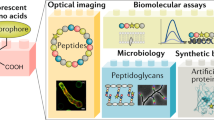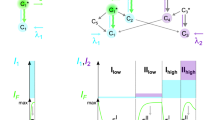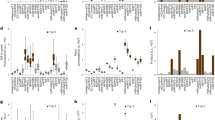Abstract
The last three decades have brought a revolution in fluorescence microscopy. The development of new microscopes, fluorescent labels and analysis techniques has pushed the frontiers of biological imaging forward, moving from fixed to live cells, from diffraction-limited to super-resolution imaging and from simple cell culture systems to experiments in vivo. The large and ever-evolving collection of tools can be daunting for biologists, who must invest substantial time and effort in adopting new technologies to answer their specific questions. This is particularly relevant when working with small-molecule fluorescent labels, where users must navigate the jargon, idiosyncrasies and caveats of chemistry. Here, we present an overview of chemical dyes used in biology and provide frank advice from a chemist’s perspective.
This is a preview of subscription content, access via your institution
Access options
Access Nature and 54 other Nature Portfolio journals
Get Nature+, our best-value online-access subscription
$29.99 / 30 days
cancel any time
Subscribe to this journal
Receive 12 print issues and online access
$259.00 per year
only $21.58 per issue
Buy this article
- Purchase on Springer Link
- Instant access to full article PDF
Prices may be subject to local taxes which are calculated during checkout






Similar content being viewed by others
References
Coons, A. H., Creech, H., Jones, R. & Berliner, E. The demonstration of pneumococcal antigen in tissues by the use of fluorescent antibody. J. Immunol. 45, 159–170 (1942).
Lavis, L. D. & Raines, R. T. Bright ideas for chemical biology. ACS Chem. Biol. 3, 142–155 (2008).
Lavis, L. D. & Raines, R. T. Bright building blocks for chemical biology. ACS Chem. Biol. 9, 855–866 (2014).
Lavis, L. D. Chemistry is dead. Long live Chemistry! Biochemistry 56, 5165–5170 (2017).
Brightman, R. Perkin and the dyestuffs industry in Britain. Nature 177, 815 (1956).
Schäfer, F. P. (ed) Dye Lasers 2nd edn (Springer, 1977).
Loudet, A. & Burgess, K. BODIPY dyes and their derivatives: syntheses and spectroscopic properties. Chem. Rev. 107, 4891–4932 (2007).
Smith, L. M. et al. Fluorescence detection in automated DNA sequence analysis. Nature 321, 674–679 (1986).
Lee, L. G. et al. DNA sequencing with dye-labeled terminators and T7 DNA polymerase: effect of dyes and dNTPs on incorporation of dye-terminators and probability analysis of termination fragments. Nucleic Acids Res. 20, 2471–2483 (1992).
Mujumdar, R. B., Ernst, L. A., Mujumdar, S. R., Lewis, C. J. & Waggoner, A. S. Cyanine dye labeling reagents: Sulfoindocyanine succinimidyl esters. Bioconjugate Chem. 4, 105–111 (1993).
Panchuk-Voloshina, N. et al. Alexa Dyes, a series of new fluorescent dyes that yield exceptionally bright, photostable conjugates. J. Histochem. Cytochem. 47, 1179–1188 (1999).
Rodriguez, E. A. et al. The growing and glowing toolbox of fluorescent and photoactive proteins. Trends Biochem. Sci. 42, 111–129 (2017).
Lambert, T. J. FPbase: A community-editable fluorescent protein database. Nat. Methods 16, 277–278 (2019).
Minta, A., Kao, J. P. & Tsien, R. Y. Fluorescent indicators for cytosolic calcium based on rhodamine and fluorescein chromophores. J. Biol. Chem. 264, 8171–8178 (1989).
Chan, J., Dodani, S. C. & Chang, C. J. Reaction-based small-molecule fluorescent probes for chemoselective bioimaging. Nat. Chem. 4, 973–984 (2012).
Huang, Y.-L., Walker, A. S. & Miller, E. W. A photostable silicon rhodamine platform for optical voltage sensing. J. Am. Chem. Soc. 137, 10767–10776 (2015).
Bai, X., Ng, K. K., Hu, J. J., Ye, S. & Yang, D. Small-molecule-based fluorescent sensors for selective detection of reactive oxygen species in biological systems. Annu. Rev. Biochem. 88, 605–633 (2019).
Wu, L. et al. Forster resonance energy transfer (FRET)-based small-molecule sensors and imaging agents. Chem. Soc. Rev. 49, 5110–5139 (2020).
Greenwald, E. C., Mehta, S. & Zhang, J. Genetically encoded fluorescent biosensors illuminate the spatiotemporal regulation of signaling networks. Chem. Rev. 118, 11707–11794 (2018).
Sabatini, B. L. & Tian, L. Imaging neurotransmitter and neuromodulator dynamics in vivo with genetically encoded indicators. Neuron 108, 17–32 (2020).
Zhang, Z., Cheng, X., Zhao, Y. & Yang, Y. Lighting up live-cell and in vivo central carbon metabolism with genetically encoded fluorescent sensors. Annu. Rev. Anal. Chem. 13, 293–314 (2020).
Tebo, A. G. et al. Orthogonal fluorescent chemogenetic reporters for multicolor imaging. Nat. Chem. Biol. 17, 30–38 (2021).
Deo, C. et al. The HaloTag as a general scaffold for far-red tunable chemigenetic indicators. Nat. Chem. Biol. 17, 718–723 (2021).
Kasha, M. Characterization of electronic transitions in complex molecules. Faraday Discuss. 9, 14–19 (1950).
Valeur, B. & Berberan-Santos, M. N. Molecular Fluorescence: Principles and Applications 2nd edn (Wiley-VCH, 2012).
Zheng, Q. & Lavis, L. D. Development of photostable fluorophores for molecular imaging. Curr. Opin. Chem. Biol. 39, 32–38 (2017).
Grimm, J. B. et al. A general method to improve fluorophores for live-cell and single-molecule microscopy. Nat. Methods 12, 244–250 (2015).
Stokes, G. G. On the change of refrangibility of light. Philos. Trans. R. Soc. Lond. 142, 463–562 (1852).
Hermann, J. P. & Ducuing, J. Dispersion of the two-photon cross section in rhodamine dyes. Opt. Commun. 6, 101–105 (1972).
Crivat, G. & Taraska, J. W. Imaging proteins inside cells with fluorescent tags. Trends Biotechnol. 30, 8–16 (2012).
Bruchez, M. P. Dark dyes–bright complexes: fluorogenic protein labeling. Curr. Opin. Chem. Biol. 27, 18–23 (2015).
Erdmann, R. S. et al. Labeling strategies matter for super-resolution microscopy: a comparison between HaloTags and SNAP-tags. Cell Chem. Biol. 26, 584–592.e586 (2019).
Koniev, O. & Wagner, A. Developments and recent advancements in the field of endogenous amino acid selective bond forming reactions for bioconjugation. Chem. Soc. Rev. 44, 5495–5551 (2015).
Haugland, R. P., Spence, M. T. Z., Johnson, I. D. & Basey, A. The Handbook: A Guide to Fluorescent Probes and Labeling Technologies 10th edn (Molecular Probes, 2005).
Lukinavičius, G. et al. A near-infrared fluorophore for live-cell super-resolution microscopy of cellular proteins. Nat. Chem. 5, 132–139 (2013).
Lukinavičius, G. et al. Fluorogenic probes for live-cell imaging of the cytoskeleton. Nat. Methods 11, 731–733 (2014).
Lukinavičius, G. et al. SiR-Hoechst is a far-red DNA stain for live-cell nanoscopy. Nat. Commun. 6, 8497 (2015).
Lukinavičius, G. et al. Fluorogenic probes for multicolor imaging in living cells. J. Am. Chem. Soc. 138, 9365–9368 (2016).
Legant, W. R. et al. High-density three-dimensional localization microscopy across large volumes. Nat. Methods 13, 359–365 (2016).
Grimm, J. B. et al. A general method to fine-tune fluorophores for live-cell and in vivo imaging. Nat. Methods 14, 987–994 (2017).
Zheng, Q. et al. Rational design of fluorogenic and spontaneously blinking labels for super-resolution imaging. ACS Cent. Sci. 5, 1602–1613 (2019).
Wang, L. et al. A general strategy to develop cell permeable and fluorogenic probes for multicolour nanoscopy. Nat. Chem. Biol. 12, 165–172 (2020).
Patterson, D. M., Nazarova, L. A. & Prescher, J. A. Finding the right (bioorthogonal) chemistry. ACS Chem. Biol. 9, 592–605 (2014).
Chin, J. W. Expanding and reprogramming the genetic code. Nature 550, 53–60 (2017).
Himo, F. et al. Copper(I)-catalyzed synthesis of azoles. DFT study predicts unprecedented reactivity and intermediates. J. Am. Chem. Soc. 127, 210–216 (2005).
Beatty, K. E., Xie, F., Wang, Q. & Tirrell, D. A. Selective dye-labeling of newly synthesized proteins in bacterial cells. J. Am. Chem. Soc. 127, 14150–14151 (2005).
Baskin, J. M. et al. Copper-free click chemistry for dynamic in vivo imaging. Proc. Natl Acad. Sci. USA 104, 16793–16797 (2007).
Chang, P. V. et al. Copper-free click chemistry in living animals. Proc. Natl Acad. Sci. USA 107, 1821–1826 (2010).
Blackman, M. L., Royzen, M. & Fox, J. M. Tetrazine ligation: fast bioconjugation based on inverse-electron-demand Diels–Alder reactivity. J. Am. Chem. Soc. 130, 13518–13519 (2008).
Devaraj, N. K., Weissleder, R. & Hilderbrand, S. A. Tetrazine-based cycloadditions: application to pretargeted live cell imaging. Bioconjug. Chem. 19, 2297–2299 (2008).
Lang, K. et al. Genetic encoding of bicyclononynes and trans-cyclooctenes for site-specific protein labeling in vitro and in live mammalian cells via rapid fluorogenic Diels–Alder reactions. J. Am. Chem. Soc. 134, 10317–10320 (2012).
Seitchik, J. L. et al. Genetically encoded tetrazine amino acid directs rapid site-specific in vivo bioorthogonal ligation with trans-cyclooctenes. J. Am. Chem. Soc. 134, 2898–2901 (2012).
Keppler, A. et al. A general method for the covalent labeling of fusion proteins with small molecules in vivo. Nat. Biotechnol. 21, 86–89 (2002).
Los, G. V. et al. HaloTag: a novel protein labeling technology for cell imaging and protein analysis. ACS Chem. Biol. 3, 373–382 (2008).
Szent-Gyorgyi, C. et al. Fluorogen-activating single-chain antibodies for imaging cell surface proteins. Nat. Biotechnol. 26, 235–240 (2008).
Miller, L. W., Cai, Y., Sheetz, M. P. & Cornish, V. W. In vivo protein labeling with trimethoprim conjugates: a flexible chemical tag. Nat. Methods 2, 255–257 (2005).
You, M. & Jaffrey, S. R. Structure and mechanism of RNA mimics of green fluorescent protein. Annu. Rev. Biophys. 44, 187–206 (2015).
Crissman, H. A. & Hirons, G. T. Staining of DNA in live and fixed cells. Methods Cell. Biol. 41, 195–209 (1994).
Kapuscinski, J. DAPI: A DNA-specific fluorescent probe. Biotech Histochem. 70, 220–233 (1995).
Nakamura, A. et al. Hoechst tagging: a modular strategy to design synthetic fluorescent probes for live-cell nucleus imaging. Chem. Commun. (Camb.) 50, 6149–6152 (2014).
Whitaker, J. E. et al. Cascade Blue derivatives: water soluble, reactive, blue emission dyes evaluated as fluorescent labels and tracers. Anal. Biochem. 198, 119–130 (1991).
Subach, O. M., Cranfill, P. J., Davidson, M. W. & Verkhusha, V. V. An enhanced monomeric blue fluorescent protein with the high chemical stability of the chromophore. PLoS One 6, e28674 (2011).
Baeyer, A. Ueber eine Neue Klasse von Farbstoffen. Ber. Dtsch. Chem. Ges. 4, 555–558 (1871).
Shaner, N. C. et al. A bright monomeric green fluorescent protein derived from Branchiostoma lanceolatum. Nat. Methods 10, 407–409 (2013).
Aaron, C. & Barker, C. C. Steric effects in di- and tri-arylmethane dyes. Part X. Electronic absorption spectra of bridged derivatives of malachite green and crystal violet. J. Chem. Soc. B Phys. Org. 1971, 319–324 (1971).
Arden-Jacob, J., Frantzeskos, J., Kemnitzer, N. U., Zilles, A. & Drexhage, K. H. New fluorescent markers for the red region. Spectrochim. Acta A 57, 2271–2283 (2001).
Grimm, J. B. et al. Carbofluoresceins and carborhodamines as scaffolds for high-contrast fluorogenic probes. ACS Chem. Biol. 8, 1303–1310 (2013).
Cooper, M. et al. Cy3B: improving the performance of cyanine dyes. J. Fluoresc. 14, 145–150 (2004).
Bindels, D. S. et al. mScarlet: a bright monomeric red fluorescent protein for cellular imaging. Nat. Methods 14, 53–56 (2017).
Mao, F., Leung, W.-Y. & Haugland, R. P. Sulfonated xanthene derivatives. US Patent 6,130,101 (2000).
Zhou, M., Diwu, Z., Panchuk-Voloshina, N. & Haugland, R. P. A stable nonfluorescent derivative of resorufin for the fluorometric determination of trace hydrogen peroxide: applications in detecting the activity of phagocyte NADPH oxidase and other oxidases. Anal. Biochem. 253, 162–168 (1997).
Gao, W., Xing, B., Tsien, R. Y. & Rao, J. Novel fluorogenic substrates for imaging β-lactamase gene expression. J. Am. Chem. Soc. 125, 11146–11147 (2003).
Chu, J. et al. Non-invasive intravital imaging of cellular differentiation with a bright red-excitable fluorescent protein. Nat. Methods 11, 572–578 (2014).
Vaughan, J. C., Dempsey, G. T., Sun, E. & Zhuang, X. Phosphine quenching of cyanine dyes as a versatile tool for fluorescence microscopy. J. Am. Chem. Soc. 135, 1197–1200 (2013).
Michie, M. S. et al. Cyanine conformational restraint in the far-red range. J. Am. Chem. Soc. 139, 12406–12409 (2017).
Liu, J. et al. Rational design and synthesis of a novel class of highly fluorescent rhodamine dyes that have strong absorption at long wavelengths. Tetrahedron Lett. 44, 4355–4359 (2003).
Shen, Z., Lu, Z., Chhatbar, P. Y., O’Herron, P. & Kara, P. An artery-specific fluorescent dye for studying neurovascular coupling. Nat. Methods 9, 273–276 (2012).
Bachman, J. L., Pavlich, C. I., Boley, A. J., Marcotte, E. M. & Anslyn, E. V. Synthesis of carboxy ATTO 647N using redox cycling for xanthone access. Org. Lett. 22, 381–385 (2020).
Fu, M., Xiao, Y., Qian, X., Zhao, D. & Xu, Y. A design concept of long-wavelength fluorescent analogs of rhodamine dyes: replacement of oxygen with silicon atom. Chem. Commun. 2008, 1780–1782 (2008).
Koide, Y., Urano, Y., Hanaoka, K., Terai, T. & Nagano, T. Evolution of group 14 rhodamines as platforms for near-infrared fluorescence probes utilizing photoinduced electron transfer. ACS Chem. Biol. 6, 600–608 (2011).
Buschmann, V., Weston, K. D. & Sauer, M. Spectroscopic study and evaluation of red-absorbing fluorescent dyes. Bioconjugate Chem. 14, 195–204 (2003).
Rodriguez, E. A. et al. A far-red fluorescent protein evolved from a cyanobacterial phycobiliprotein. Nat. Methods 13, 763–769 (2016).
Zhou, X., Lai, R., Beck, J. R., Li, H. & Stains, C. I. Nebraska Red: a phosphinate-based near-infrared fluorophore scaffold for chemical biology applications. Chem. Commun. 52, 12290–12293 (2016).
Grimm, J. B. et al. A general method to optimize and functionalize red-shifted rhodamine dyes. Nat. Methods 17, 815–821 (2020).
Luciano, M. P. et al. A nonaggregating heptamethine cyanine for building brighter labeled biomolecules. ACS Chem. Biol. 14, 934–940 (2019).
Cosco, E. D. et al. Shortwave infrared polymethine fluorophores matched to excitation lasers enable non-invasive, multicolour in vivo imaging in real time. Nat. Chem. 12, 1123–1130 (2020).
Shcherbakova, D. M., Cox Cammer, N., Huisman, T. M., Verkhusha, V. V. & Hodgson, L. Direct multiplex imaging and optogenetics of Rho GTPases enabled by near-infrared FRET. Nat. Chem. Biol. 14, 591–600 (2018).
Matlashov, M. E. et al. A set of monomeric near-infrared fluorescent proteins for multicolor imaging across scales. Nat. Commun. 11, 239 (2020).
Frank, W. G., Wenzel, M. S., Czerney, P. T., Desai, S. & Hermanson, G. Sulfonamide derivatives of xanthene compounds. US Patent 7,745,645 (2010).
Mao, F., Leung, W.-Y., Cheung, C.-Y. & Hoover, H. E. Fluorescent dyes, fluorescent dye kits, and methods of preparing labeled molecules. US Patent 8,709,830 (2014).
Thevathasan, J. V. et al. Nuclear pores as versatile reference standards for quantitative superresolution microscopy. Nat. Methods 16, 1045–1053 (2019).
Bucevicius, J., Kostiuk, G., Gerasimaite, R., Gilat, T. & Lukinavicius, G. Enhancing the biocompatibility of rhodamine fluorescent probes by a neighbouring group effect. Chem. Sci. 11, 7313–7323 (2020).
Verheijen, M. et al. DMSO induces drastic changes in human cellular processes and epigenetic landscape in vitro. Sci. Rep. 9, 4641 (2019).
Grimm, J. et al. A general method to improve fluorophores using deuterated auxochromes. JACS Au. 1, 690–696 (2021).
Butkevich, A. N., Bossi, M. L., Lukinavicius, G. & Hell, S. W. Triarylmethane fluorophores resistant to oxidative photobluing. J. Am. Chem. Soc. 141, 981–989 (2019).
Gidi, Y. et al. Unifying mechanism for thiol-induced photoswitching and photostability of cyanine dyes. J. Am. Chem. Soc. 142, 12681–12689 (2020).
Zheng, Q. et al. Ultra-stable organic fluorophores for single-molecule research. Chem. Soc. Rev. 43, 1044–1056 (2014).
Isselstein, M. et al. Self-healing dyes—keeping the promise? J. Phys. Chem. Lett. 11, 4462–4480 (2020).
Grimm, J. B. & Lavis, L. D. Synthesis of rhodamines from fluoresceins using Pd-catalyzed C–N cross-coupling. Org. Lett. 13, 6354–6357 (2011).
Herner, A. et al. New generation of bioorthogonally applicable fluorogenic dyes with visible excitations and large Stokes shifts. Bioconjug. Chem. 25, 1370–1374 (2014).
Horvath, P., Sebej, P., Solomek, T. & Klan, P. Small-molecule fluorophores with large Stokes shifts: 9-iminopyronin analogues as clickable tags. J. Org. Chem. 80, 1299–1311 (2015).
Dwight, S. J. & Levin, S. Scalable regioselective synthesis of rhodamine dyes. Org. Lett. 18, 5316–5319 (2016).
Lavis, L. D. What if we just give everything away? eLife 10, e74981 (2021).
Acknowledgements
We thank E. Schreiter for assistance with protein structures and E. Betzig, U. Boehm, X. Darzacq, B. English, H. Farrants, A. Hansen, Z. Liu, T. Lionnet, J. Lippincott-Schwartz, J. Schmidt and S.-H. Shu for contributive discussions. Related work in our laboratory is supported by the Howard Hughes Medical Institute. Chemical structures and spectral data were taken from references or obtained from vendor websites.
Author information
Authors and Affiliations
Contributions
J.B.G. and L.D.L. wrote and edited the manuscript.
Corresponding author
Ethics declarations
Competing interests
The authors declare the following competing financial interest: patents and patent applications describing azetidine-, fluorine- and deuterium-containing fluorophores (with inventors J.B.G. and L.D.L.) are assigned to Howard Hughes Medical Institute.
Peer review information
Nature Methods thanks Lu Wang and the other, anonymous, reviewer(s) for their contribution to the peer review of this work. Rita Strack was the primary editor on this article and managed its editorial process and peer review in collaboration with the rest of the editorial team.
Additional information
Publisher’s note Springer Nature remains neutral with regard to jurisdictional claims in published maps and institutional affiliations.
Rights and permissions
About this article
Cite this article
Grimm, J.B., Lavis, L.D. Caveat fluorophore: an insiders’ guide to small-molecule fluorescent labels. Nat Methods 19, 149–158 (2022). https://doi.org/10.1038/s41592-021-01338-6
Received:
Accepted:
Published:
Issue Date:
DOI: https://doi.org/10.1038/s41592-021-01338-6
This article is cited by
-
Real-time single-molecule imaging of transcriptional regulatory networks in living cells
Nature Reviews Genetics (2024)
-
A general strategy to develop fluorogenic polymethine dyes for bioimaging
Nature Chemistry (2024)
-
Ultra-photostable small-molecule dyes facilitate near-infrared biophotonics
Nature Communications (2024)
-
Chromatin structure and dynamics: one nucleosome at a time
Histochemistry and Cell Biology (2024)
-
Liquid-activated quantum emission from pristine hexagonal boron nitride for nanofluidic sensing
Nature Materials (2023)



